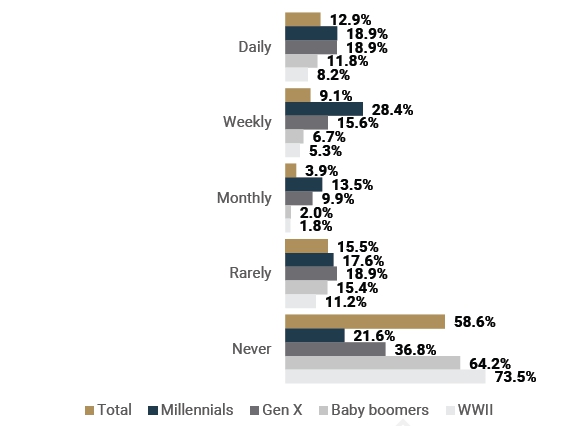Harness Your Online Presence – Episode 19
There’s no question that many affluent investors are increasingly turning to technology as an essential part of their investment journey. That means they’re looking to you—their advisors—to offer tech-enhanced access to information, insights and communication.
That said, the desire for technology can vary greatly depending on the types of clients you serve. Generally—and probably not surprisingly—younger wealthy clients have higher expectations for what you offer them via your website and on social media than do older generations.
That said, it seems like just about everyone is become more comfortable with technology over time. With that in mind, here’s a look at affluent investors’ latest attitudes about some key technologies—and the potential implications of those attitudes on your practice.
Key Takeaways:
- The majority of your clients likely visit your website regularly.
- Younger clients are more likely to seek out financial information on social media.
- Your online content needs to look great and convey your expertise.
FACE THE FACTS
CEG Insights recently surveyed more than 1,500 households—all with more than $100,000 of net worth* and most with a net worth of more than $1 million—about how they prefer to get educational information from their advisors, as well as their perceptions of how their advisors are communicating with them.
CEG Insights recently surveyed more than 800 investors—all with at least $100,000 in net worth, but most with a net worth of at least $1 million.* In particular, we asked them about their usage habits when it comes to two types of technology—your firm’s website, and social media.
1. Your website. Your website is likely the first place prospective clients visit when vetting you, of course, But it’s also a valuable tool for most of your existing clients. According to our research, 15% of investors access their advisor’s website daily, while 28.7% access it weekly and 30.2% access it monthly. Only 12.2% of clients never access their advisor’s website.
Older clients often visit their advisor’s website to check on balances and review factual data about their accounts. Younger clients—millennials and Gen-Xers, for example—tend to want more interactive experiences, such as trading, bill payment, informational videos and up-to-date information.
Importantly, younger investors also are more willing than older investors to move assets to an advisor whose website offers the features they desire:
- 38% of Gen-X investors say they would be at least somewhat likely to move more assets to an advisor whose website provides desired features.
- More than 50% of millennials feel the same.
- Nearly 55% of baby boomers are unlikely to move assets based on their advisor’s website.
2. Social media. The most popular social media platforms among advisors’ clients are the ones you’d expect: Facebook (52.6% of clients regularly use it), YouTube (29.2%) and LinkedIn (22.6%).
That said, most clients—58.6%—say they never use social media to get financial news or information. Does that mean you can safely ignore social media? Probably not. We also found that significant percentages of younger affluent clients use social media to inform their investing (see Exhibit 1). Note how just about one-fifth of millennials say they never use social media for financial information, and less than 40% of Gen-Xers agree.
How Often Investors Use Social Media for Financial News and Information (By age)

What’s more, over a quarter of millennials (25.7%) and 23.1% of Gen X investors want their advisors to provide educational content and insights—such as videos and webinars on market analysis and personal finance ideas—through social media.

INSIGHTS INTO ACTION
Given the differing interest levels in technology among clients based largely on age, advisors should keep a few things in mind as they plot out and hone their tech initiatives.
- Be thoughtful and deliberate. Develop a social media plan before simply posting content online. If you serve primarily older clients, they may not engage with your social media content deeply. If you serve (or seek to serve) younger clients, a social media presence is more important to client attraction and retention. LinkedIn, for example, can serve as a way to communicate in ways that enhance your credibility among clients and prospective clients. Videos on YouTube can also be a way for prospective clients to get to know you better before ever meeting you in person.
- Build an engaging website. Don’t make your website simply a static brochure. Educational videos, personal finance calculators and assessment tools should be part of your website resources—especially if you’re looking to attract and retain younger investors who value interactive websites that they can engage with.
- Make it look great. Your website and social media content should convey your professionalism at every step. If you create video content, invest in good lighting, sound and editing software. If you post written content, have it reviewed by a proofreader before it goes out into the world.
SCHEDULE YOUR FREE PLAY TO WIN CONSULTATION NOW

